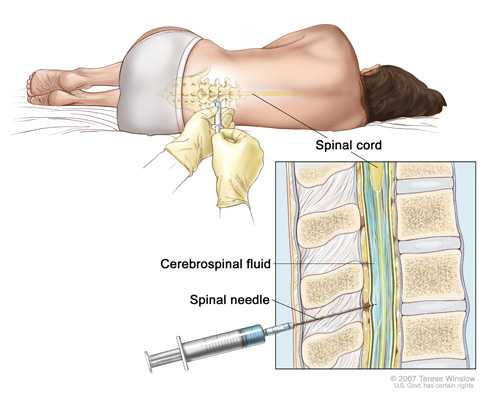Diagnosis, Treatment, and Complications
On This Page
Meningococcal disease is very serious and can be deadly in a matter of hours. Early diagnosis and treatment are very important.
Diagnosis
Meningococcal disease can be difficult to diagnose because the signs and symptoms are often similar to those of other illnesses. If a doctor suspects meningococcal disease, they will collect samples of blood or cerebrospinal fluid (fluid near the spinal cord; see image below). Doctors then test the samples to see if there is an infection and, if so, what germ is causing it. If Neisseria meningitidis bacteria are in the samples, laboratorians can grow (culture) the bacteria. Growing the bacteria in the laboratory allows doctors to know the specific type of bacteria that is causing the infection. Knowing this helps doctors decide which antibiotic will work best. Other tests can sometimes detect and identify the bacteria if the cultures do not.
Lumbar puncture to collect sample of cerebrospinal fluid

©Teresa Winslow – US Government has certain rights
Treatment
Doctors treat meningococcal disease with a number of effective antibiotics. It is important that treatment start as soon as possible. If a doctor suspects meningococcal disease, they will give the patient antibiotics right away. Antibiotics help reduce the risk of dying.
Depending on how serious the infection is, people with meningococcal disease may need other treatments, including:
- Breathing support
- Medications to treat low blood pressure
- Wound care for parts of the body with damaged skin
Complications
Even with antibiotic treatment, 10 to 15 in 100 people infected with meningococcal disease will die. About 11 to 19 in 100 survivors will have long-term disabilities, such as loss of limb(s), deafness, nervous system problems, or brain damage.
- Page last reviewed: March 28, 2017
- Page last updated: March 28, 2017
- Content source:
- Content source: National Center for Immunization and Respiratory Diseases


 ShareCompartir
ShareCompartir